I think a croissant is one of the greatest baked goods to eat, with its crisp outer shell that rains flakes as you bite into it, revealing an open honeycombed interior. And then there’s its rich buttery flavour with an almost nutty aroma. A total joy!
Sections in this post
- Introduction
- About the recipe
- Notes on the ingredients
- The importance of both dough and butter texture
- The different turns
- The value of the trimmings!
- RECIPE FOR CROISSANT DOUGH
- How to shape the dough for pains au chocolat
- Top tips
- Variations
- A rough timescale for making croissants
- Sourdough croissants
- Quicker croissants
Introduction
I have been fascinated by croissants since I was a boy and making them is right up there as one of my top baking joys.
Croissants are, I think, one of the more challenging bakes (up there with macarons in terms of difficulty) but they are so rewarding to make.
It might take a few goes to feel more comfortable with the process, but I think that is part of the joy of baking.
The photos in this tutorial are of different batches I have made. I am certainly not claiming these to be perfect (and I am learning all the time!), but in terms of flavour, flakiness and lightness, I am very happy with these!
They are not the quickest things to rustle up but the time is mostly the dough chilling or proving.
I normally start croissants the night before – typically on a Friday evening! – and bake them later the following day.
The great news is there is no urgency with the timings and you can get on with other things while the dough rests in the fridge.
About the recipe
I have tried scores of recipes over the decades in my quest to make what for me is a good croissant.
The recipe below takes ideas from the many approaches I have worked through and gives me the best results overall: now, I could go for more of a cavernous, honeycomb structure inside but I am happy with my typical structure:
But while I like to make slight changes from time to time, the recipe below is always the most up-to-date version and will give great croissants.
Notes on the ingredients
The flour
A strong plain flour (or bread flour) is best as you need the higher level of gluten (protein) in there to give a firm enough structure to the croissants: I find 12-13% protein content is ideal – any higher than that and even with a well rested dough, it can be hard to roll out towards the end.
Decades ago I used standard plain flour. Being lower in protein/less gluten it gave a dough that was easier to roll out without resisting. However, a lower protein content gives a weaker structure, so you don’t get as open an interior in the baked croissants.
The butter
A good quality butter with a high fat content (at least 82%) is best for croissants and the lamination: ie) the very thin layers of butter and dough. I get great results using Lurpak or President.
A little butter is mixed into the dough at the start. Fat hinders gluten development so this small amount of butter in the initial dough ensures the dough will roll out easily at each stage: when the dough is first made up and kneaded, it will still have enough gluten development for structure, though.
The bulk of butter gets flattened to a thin slab before being encased in the dough and then rolled out for folds/turns to create the layers ie) the lamination. I typically go for a square slab of butter but I occasionally go for a rectangle: it doesn’t actually matter as long as the dough has been rolled out enough to fully encase it. See “The different turns” below.
You can increase or even reduce the butter for being encased if you wish but aim for around 30-35% of the weight of the initial dough that gets made and lightly kneaded.
The liquid
You can use all water or a mixture of water and milk. Milk adds flavour, as well as giving a dough that is slightly easier to roll out. The liquid needs to be cold to stop the yeast from activating too soon: if it does activate too soon, it becomes much harder to roll out.
I add enough liquid to give a firm dough at the start rather than the softer dough you typically get for bread. A firm dough will be easier to get to a similar texture to the butter: this is crucial as it helps with successful lamination as there is less danger of firmer butter breaking though a softer dough.
The yeast
I sometimes use fresh yeast but I favour dried “instant” yeast: the type that is simply added to the flour without activating in water first. I’ve really not found any noticeable difference in flavour.
Don’t get too worried about the precise amount of yeast – and this is the same for other yeasted doughs. If you add less, the dough will still rise – it will just take a bit longer. However, adding too much can make the dough rise too quickly that it is hard to keep track of, and with quicker rises with yeasted doughs you never quite get the flavour that comes with slower rises.
When it comes to the proving/rise of the shaped croissant dough it is important to look at the dough, NOT the time!
One of the tricks with croissant making is to ensure the yeast does not activate during the rolling/folding/shaping stages. If it does, then the dough becomes difficult to work with and you can feel it resisting. Chilling the dough right down, even freezing it for a bit (10-15 minutes or so at a time), helps significantly. Fear not: freezing won’t kill the yeast – it merely puts it to sleep. This freezing also firms up the softening butter.
You have to be patient with the final proving (rising) of the shaped croissants as the butter, the sugar and the chilling will have slowed down the activation of the yeast. I’ve giving pointers for what to look for in the recipe so that you get the right level of prove/rise before baking.
The sugar
I usually use caster sugar but you can vary this. I sometimes like to use a brown sugar (such as muscovado) which gives a different depth of flavour, and occasionally I have a mixture of sugars.
You can increase or decrease the sugar by about 10g or so if you wish but if you add too much, you get a softer interior with less open holes. But don’t cut out the sugar altogether as it really adds to the flavour profile of the finished croissants.
The salt
I use a fine sea salt so it dissolves easily into the dough. As well as adding flavour, the salt is essential for helping to strengthen the gluten, which is needed for maintaining the structure of the dough. And it’s an important balance to strike, contrasting with the butter and sugar which weaken gluten.
The importance of both dough and butter texture
The texture of both the dough and the butter is crucial: the closer to each other they are in terms of texture, the better the lamination will be, resulting in more well-defined layers and an open interior.
The butter can’t be too soft, otherwise it simply starts to melt and you feel it squishing when you roll out the dough. The result is doughy, dense bread. If the butter is too hard it shatters into tiny hard fragments, ruining some of the layers.
The butter must be pliable rather than solid so that it also doesn’t rip through the dough or break apart. To check it’s at the right texture, bend over a corner of the butter: if it bends easily without snapping it’s pliable enough.. If it snaps, leave it at room temperature to soften just enough to be pliable.
Another key issue is when the dough is softer than the butter, when they need to be as similar in texture as possible. If the dough is too soft, the firmer butter easily tears through it, ruining the layers and resulting in a doughier interior.
To get the dough and butter at a very similar texture: have the dough VERY cold initially (a blast in the freezer is ideal) – and remove the flattened butter from the fridge just before taking the dough out of the fridge until it become pliable.
Thereafter, resting the dough on the work surface for a few minutes or so before rolling out will help the butter soften enough to match the texture of the dough.
The different turns
The turns are where the real magic happens: rolling out and folding the dough a few times to create those beautiful layers.
The chilled dough gets trimmed, rolled out and is then ready to have an envelope turn or a book turn:
Book turn: folded to give 4 dough layers
- Roll out the dough to a long, thin rectangle.
- Trim just the two shorts edges to expose the butter inside
- Fold the bottom edge of the dough over part way, keeping the edges as straight as possible
- Fold the top edge of the dough over to meet the other edge
- Fold the dough in half
- Wrap and chill for an hour or so to relax the gluten
- Once chilled, rotate the dough 90° before rolling out again
Envelope turn: folded to give 3 layers
- Roll out the dough to a long, thin rectangle.
- Trim just the edge closest to you to expose the butter inside
- Fold the bottom third of the dough up, keeping the edges as straight as possible.
- Now bring the top third of the dough over this, keeping the edges as straight as possible.
- Wrap and chill for an hour or so to relax the gluten
- Once chilled, rotate the dough 90° before rolling out again
Trimming the edges is not essential but it ensures there are no closed dough bits inside. This helps achieve the lightest interior in the final croissants.
You can give different numbers and combinations of these turns depending on what your croissant preference is:
3 envelope turns: I usually go for 3 envelope turns, which gives a suitably flaky exterior with a nice open structure. The holes inside are medium sized:
One book turn and one envelope turn: I go for this combination when I want larger holes inside. A key advantage is this cuts out an entire set of rolling out: ideal if it’s a very hot kitchen! There won’t be as many visible layers on the outside, but you still get a very flaky croissant and a slightly more open interior:
If you try to do too many turns (such as four envelope turns or slipping in additional book turns) there’s a greater risk of compressing the layers which will result in a denser interior, as in the photo below:
The value of the trimmings!
Whenever you trim the dough, either during the turns or when it comes to shaping, don’t throw them away. You can use these trimmings to make them into buttery rolls.
However, I sometimes save the trimmings to add to a later dough to really boost its flavour:
- let the trimmings prove at room temperature (you get the best flavour that way) before shaping them into small balls: I don’t tend to weigh them but roughly 30g or so for a main dough that uses 250g flour.
- wrap the trimmings in clingfilm and freeze until you want to use them – at which point just pop a defrosted ball into the mixing bowl at the start: it will integrate with the rest of the dough easily.
Recipe for croissant dough: makes 8 croissants
NB: I’ve scaled down my initial recipe to give a smaller amount of dough which I now use when I give croissant-making tutorials.
Initial dough:
- 250g strong white plain flour
- 10g “instant” dried yeast
- 5g fine salt
- 25g caster sugar
- 25ml semi-skimmed milk
- 100ml cold water
- 25g soft, unsalted butter
To laminate the dough:
- 150g unsalted butter
To glaze:
- 1 egg, beaten
You also need baking trays lined with a double layer of parchment
Make the initial dough:
(1) Mix the initial dough ingredients together in the bowl of a food mixer to give a fairly firm dough, adding just a little extra water if needed to help it all come together. Knead gently on a low setting for about 5 minutes: just enough to bring it together to form a fairly smooth dough with just a little elasticity.
NB: you don’t want to develop the gluten too much here; the rolling out of the dough later will develop the gluten and give structure to the final croissants.
(2) Place in a bowl and cover. Leave it at room temperature for about a hour to allow the yeast to start to activate and for the dough to expand a little: it doesn’t need to get to twice the volume as you would with a standard bread dough.
NB: you don’t want it to rise too much and have the yeast use up its food at this point as it won’t then be able to give a decent rise before baking later. However. this light fermentation starts off the flavour development.
(3) Deflate the dough, wrap in clingfilm and put onto a baking tray. Freeze for about 30 minutes and then roll out to a rough rectangle – about 32cm by 16cm – before wrapping it well again.
NB 1: the freezing puts the yeast to sleep so that when it is chilled overnight the dough won’t over-rise or use up its food supply in the dough (which would mean the shaped dough won’t rise much later). There is still only a little fermentation at this stage, but this is where a lot of the flavour comes from.
NB 2: by shaping it to a rough rectangle now, there is little rolling out to do when it comes to encasing the butter slab. That way, the gluten will be relaxed enough so that the dough rolls out easily later on.
NB 3: after doing this you can either put the flattened dough in the fridge overnight and then the next morning encase the butter, do the turns, shape the dough, rise and bake…..
OR
encase the butter and do the turns now (steps 4 – 11) and then leave in the fridge overnight so that next morning you simply roll out the dough one final time, shape, rise and bake.
Make the butter slab:
(4) Shape the butter into a thin square that is about 16cm by 16cm by bashing it lightly with a rolling pin between two sheets of baking parchment. Chill the butter until you are ready to encase it in the dough. If you’re doubling the recipe, go for a larger square: about 20cm by 20cm.
NB: this can be done in advance. I often make up several squares of butter and pop them in the freezer to use when I want to make croissants: in which case, I just defrost a square of it in the fridge overnight along with the initial dough so it is ready to be encased.
(5) Remove the butter from the fridge for a few minutes: just long enough for it to be flexible and not at all brittle. Meanwhile, transfer the flattened dough from the fridge to the freezer for about 10 minutes while the butter gets to a pliable texture. To test the butter is at the right texture, bend a corner over: if it snaps, it is too firm, in which case leave it at room temperature just until it can bend easily without snapping.
NB: I find the short freezing of the dough, while the butter is out of the fridge to become pliable, is ideal for getting butter and dough to as similar a texture as possible. It also makes the first rolling out very easy.
Encase the butter in the dough:
(6) Turn the chilled dough onto a lightly floured work surface. It should hold its shape but you can roll it out a little if needed so it is just wider than the butter square and just over twice as long ie) just over 32cm by 16cm.
(7) Rotate the dough so long edge is closest to you and place the butter in the centre. Bring the rest of the dough over the butter, sealing gently and trying not to trap air bubbles.
Alternatively you can encase the butter this way and seal all edges:
Roll out dough ready to start the turns:
(8) Use the rolling pin to lightly press down on the dough along the length a few times, giving small ridges to begin with. This helps elongate the dough without using much pressure, and helps the butter spread just enough to roll out easily within the dough.
(9) Lightly roll out to give a long, narrow rectangle about three times as long as it is wide: ie) about 16cm wide and 48-50cm long. Brush off any excess flour again: you don’t want this trapped inside the dough as this hinders the open structure later.
NB: the trick is to gently press the rolling pin onto the dough a few times along its length to start to flatten it and then gently rolling out. Ideally rotate the dough from time to time so it is even. The rolled out dough should be between about 5mm and 10mm thick.
Perform the turns (creating the layers)
(10) Use a sharp knife to trim the short edge nearest to you so you can see the butter inside. Now perform the types and number turns you would like, making sure you rotate the dough 90° after each turn and chill (about an hour in the fridge).
NB: go for either 3 envelope turns or a book turn followed by an envelope turn…. (see “The different turns” above).
(11) Wrap up the dough and put in the coldest part of the fridge for about an hour to rest. If it is a particularly warm kitchen, it is best to freeze the dough for about 15 minutes and then put in the fridge for an hour or so:
NB: it’s not a precise time, but an hour or so is enough time to allows the gluten to relax, so that the next rolling will be easier. It also firms the butter back up, as it will have softened during the last roll.
(12) After the final turn, wrap up the dough and refrigerate for 2-3 hours, or even overnight: it won’t rise too much as the dough will be very cold.
NB : the dough benefits hugely from this final resting as you get a dough that rolls out more easily for the final time for the cutting and shaping.
(13) Remove the dough from the fridge and leave it on the lightly floured work surface for about 5-10 minutes to allow the butter in the dough to soften just enough to become pliable again.
Shaping
(14) Roll out the dough thinly to a rectangle just over 36cm by 22cm.
NB 1: if the dough resists when rolling it out for this final time, or if you see any butter leaking, chill for about 20 minutes before carrying on rolling: it will get there!
NB 2: you can roll out to a longer but narrower rectangle if you wish – around 50cm by 18cm is a common variation for me if I want a few more croissants that are slightly smaller.
(15) Trim the edges with a sharp knife and cut into triangles with bases about 8cm and height about 22cm: you can use my rough sketch below as a guide to how you can cut the dough. Chill the triangles if the butter feels too soft.
(16) Take a triangle and stretch the base a little to widen it by a centimetre or so. Using your fingertips gently stretch out the triangle’s tip, to elongate it a bit more. Roll it up from the base but not too tightly and have the tip of the triangle underneath.
(17) Place on the baking trays, patting down lightly. Repeat with the other triangles. The “before and after” photos of this type of shaping are in the photos below:
For an alternative way to shape, fold in the 2 corners at the base of the triangles before rolling them up: as in the photos below (Buchon Bakery-style!). This way gives more rounded ends if you prefer that look.
(18) Put the shaped dough well spaced out on baking trays lined with a double layer of greaseproof paper.
Proving and baking
(19) Pop the trays in large bin liners and leave at room temperature until puffy and well risen or a dough proofer set to 25-26°C. If you give the tray a gentle shake, the croissants should wobble a bit. Be patient as this proving can take 3-4 hours in cool room temperature. I find in the dough proofer it takes between around 90 minutes to 2 hours.
Important: don’t over-prove. If the dough over-proves you will see signs of the dough tearing on top and the croissants will be prone to collapsing, so after a couple of hours periodically check what’s happening. I often use one of the off-cuts on a separate baking tray as a guide.
NB 1: I find popping the trays inside a large bin liner is easiest, with a tin or mug inside to keep the plastic from touching the dough.
NB 2: Make sure the room is not too warm (not much higher than around 26°C) otherwise the butter can melt and you end up with greasy, dense croissants. However, if the room is on the colder side, the shaped dough will still rise but it will take longer.
(20) Brush the egg lightly all over the risen dough. It is absolutely fine to get the egg over the cut parts of the dough, as it really does not affect the expansion significantly.
(21) Preheat the oven to 200°C (fan) and place the egg-washed dough into the oven. As soon as they are in, turn the oven down to 175°C (fan) and cook for about 15 minutes: they should be a golden brown and feel light when you lift one up.
NB: keep an eye on them as they bake: after about 10-12 minutes you might want to rotate the pans depending on your oven. The pastries will already show flaky layers, giving a teaser as to what is to come: arguably the most exciting part of the entire process!
Shaping the dough for pains au chocolat
Roll out the rested dough as in Step 14 of the recipe above.
Shaping pains au chocolat (makes 10 small ones)
- Cut the rolled out dough into rectangles about 8cm by 10cm: you can bake the trimmings or freeze them to add to a later dough.
- Take a rectangle of dough and gently stretch it with cold fingers so it is a few centimetres longer.
- Place a chocolate baton/chocolate chips/chunks of chocolate width-ways close to the bottom of each rectangle and roll the bottom of the dough up over it. You can have the chocolate going right to the sides or go for the hidden chocolate effect!
- Place more chocolate at the “join” and roll all the way to the end. If the dough is on the thick side and you can’t quite get two lots of chocolate in there, pop a little more chocolate with the first lot.
- Place on baking trays with the seam face down and gently pat down each one.
Top tips for croissant dough
While it might take a few goes at making croissants to get a real feel for them, these tips should help achieve excellent results:
Try to avoid making a laminated dough on a hot day in a warm kitchen
A warm kitchen makes croissant making even more of a challenge. If you are going to make them on a warm day, expect to have more frequent freezing (10-15 mins at a time) and/or refrigerating (30 minutes or so) to prevent the butter softening too much. This more frequent chilling might feel a bit of a pain but it really helps.
In a warm kitchen I would go for just two turns: a book turn and then an envelope turn. This cuts out the need for another turn, which can be a chore in the heat, but you still get great croissants.
I sometimes pop bags of frozen veg on the worktop where I am going to be rolling out so the worktop is very cold: in which case, give it a wipe down so there is no condensation!
Brush any excess flour off the surface of the dough
Too much flour trapped between the layers will affect the lamination and give a heavier, doughier interior rather than a light, open structure. Use a pastry brush or clean paint brush to flick the surplus flour away each time you have rolled out and as you fold up the dough for the turns.
Line the baking trays well
I always go for a double thickness of greaseproof paper, as these pastries are prone to getting overly dark on their bases.
Don’t rush the proving of the shaped dough
Leave the shaped dough at room temperature to prove. You want the shaped dough to be puffy and with a slight wobble, and you should be able to see the layers of butter in there: this is always an exciting thing to see.
It will prove in a cool room (albeit slowly) or perhaps 2-3 hours if the room is warm. Don’t be tempted to pop the dough into the airing cupboard as it will be too warm and the butter might melt.
However, it is important to check the dough and not the time!
Check the progress of dough after a couple of hours and thereafter every half hour or so: you want to avoid any over-proving which will be the case of the dough starts to tear on top, so be ready with the oven.
Don’t under-bake
Croissants start to brown up fairly quickly and it is easy to take them out thinking they are ready, only to find them collapsed or doughy inside! You can afford to go a darker golden-brown with croissants and pains au chocolat.
To test they are ready: the tops should be firm and crispy and they should lift easily off the tray, feeling very light.
A rough timescale for making croissants:
Making croissants is more a weekend affair for me, and I often stick to a timescale similar to the one given below. These timings are merely loose guidelines but they always work well for me!
- Day one – evening: make up the initial dough and refrigerate overnight. Make the butter block and also refrigerate overnight
- Day two – 9am: encase the butter block in the dough, roll out and do the turns.
- Day two – midday: chill the laminated dough
- Day two – 2pm: roll out the dough, shape and leave to prove/rise for 2-3 hours or until puffy and jiggly
- Day two – about 6pm: bake!
Variations
Below is a selection of some of my favourite variations. You can scale the ingredients down as I’ve done with the main recipe above if you want to work with a smaller amount of dough.
One of my favourite sweet variations is bitter orange pains au chocolat incredibly indulgent and divine to eat slightly warm.
But I am quite partial to chocolate and ginger pains au chocolat
Mind you, spreading salted caramel over the dough before adding the chocolate and shaping gives wonderful salted caramel pains au chocolat:
My favourite savoury variations include:
croissant-based “pizza” (topped with slow-roasted onions, anchovies and olives) – my croissantdough version of the classic pissaladière:
croissage rolls (essentially sausage rolls made using croissant dough rather than puff pastry)
bacon and goats’ cheese “cruffins”: strips of croissant dough rolled up and shaped in muffin tins before getting filled
Sourdough croissants:
A sourdough croissant has an even crisper exterior and has even more depth of flavour that a croissant made with commercial yeast.
My recipe for sourdough croissants is here.
Quicker croissants:
You can incorporate the butter grated from a frozen block of butter, which gives a dough that takes about 20 minutes to make up (before it needs to rest, get shaped and prove).
This is certainly an easier method and it is much quicker to get the dough laminated, taking no more than half an hour. While the dough still benefits from overnight resting prior to shaping, it works very well with just a few hours rest in the fridge before shaping.
The result is a flaky croissant with a nice structure, although it does not have quite the same level of honeycombed interior as you get with the traditional method. But it does give a very nice croissant indeed!
My recipe for these quicker croissants is here.

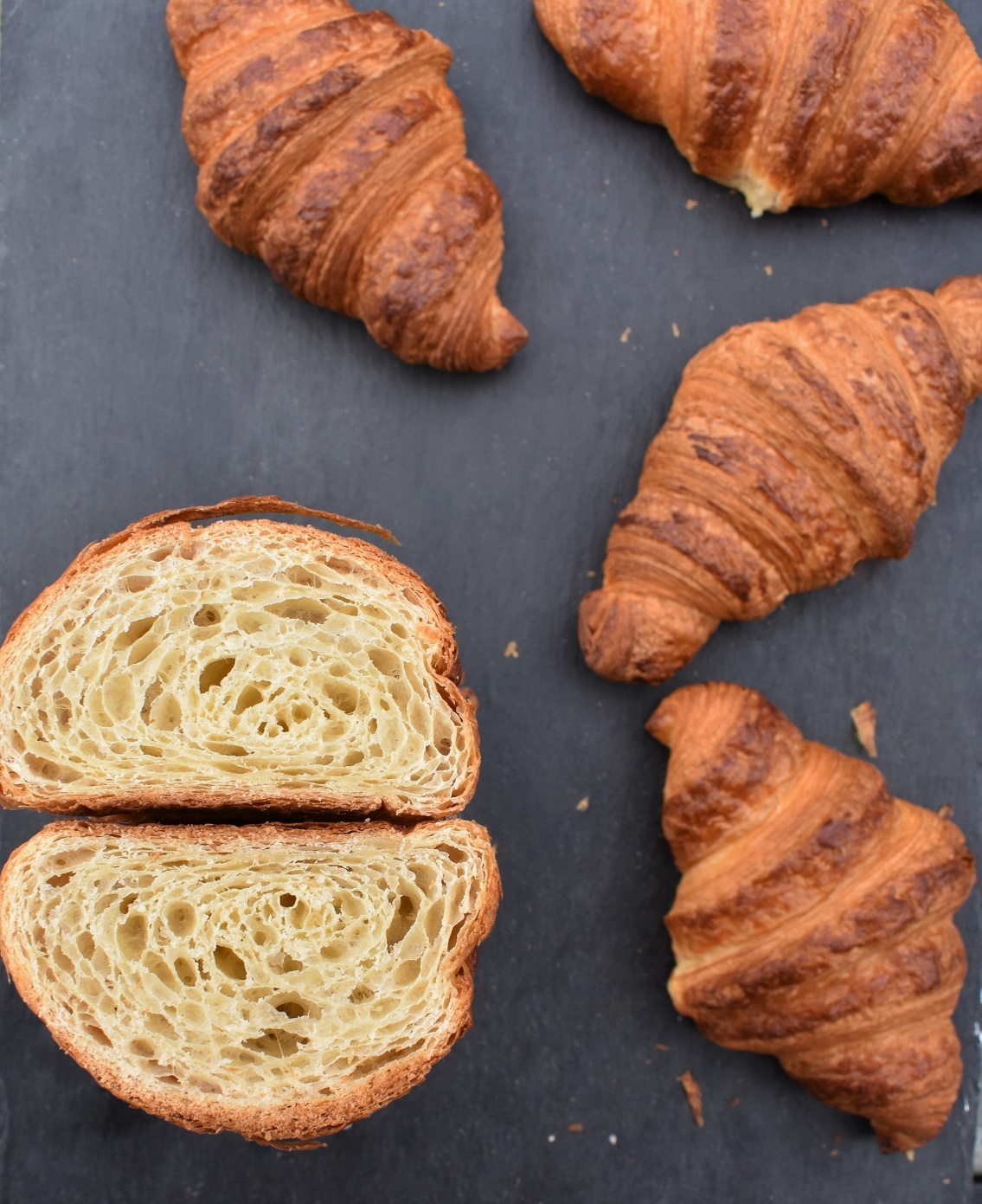














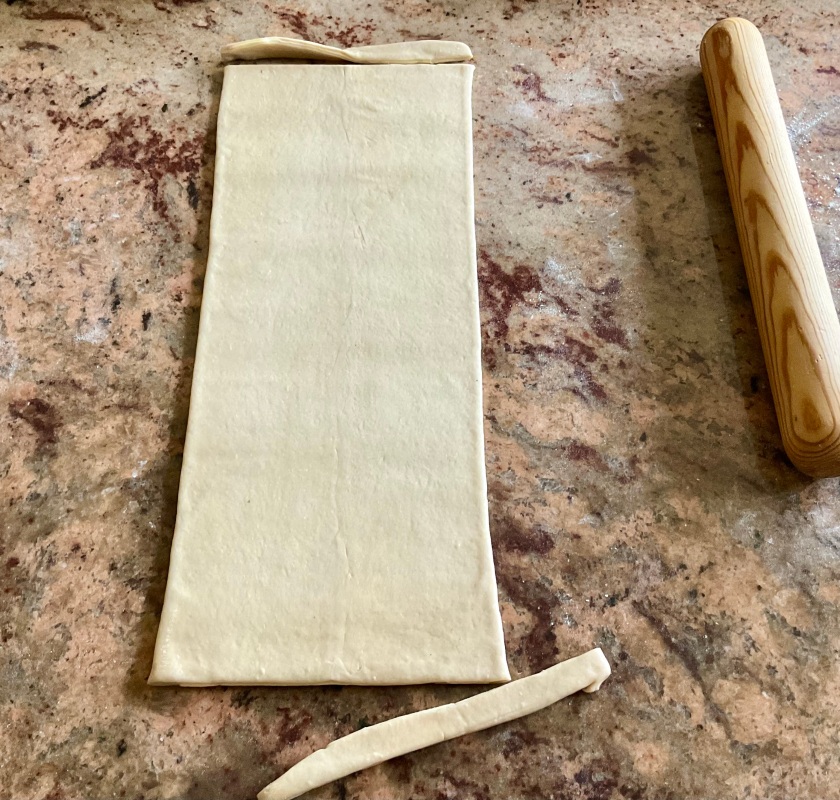
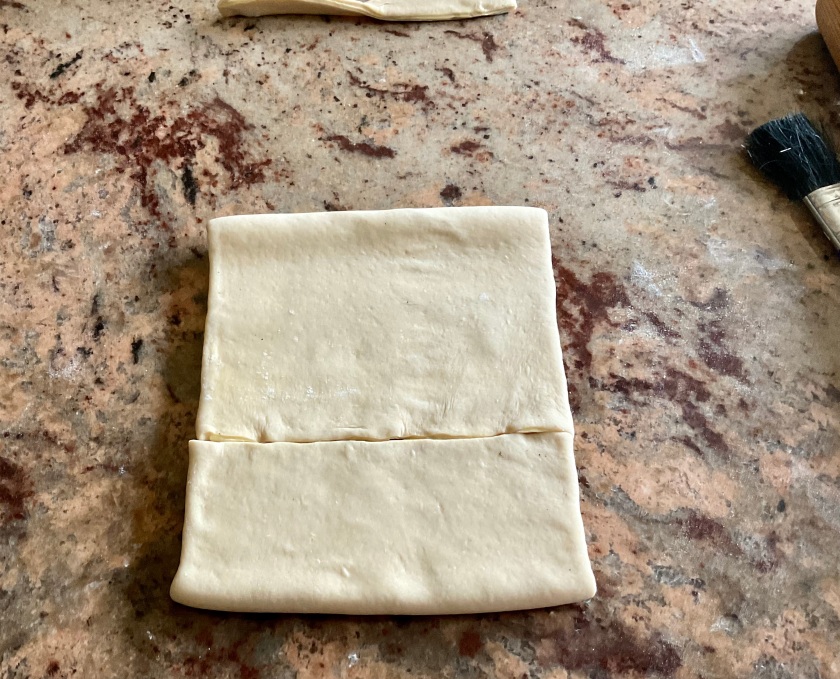

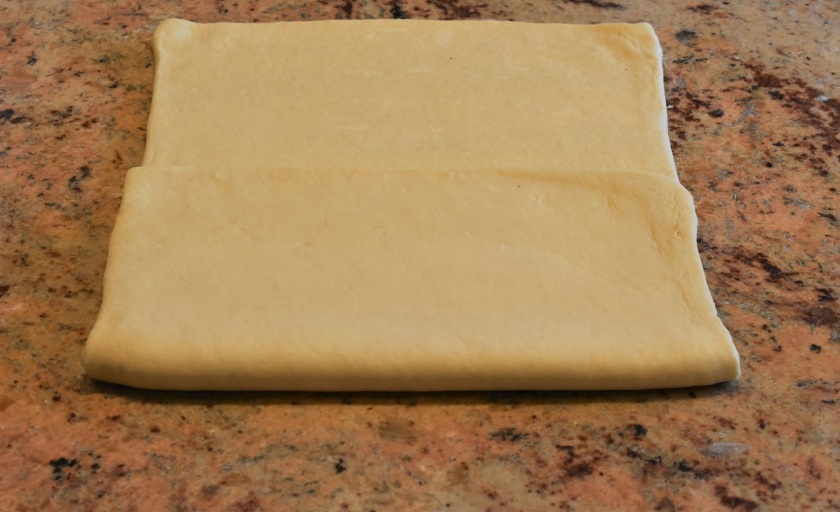
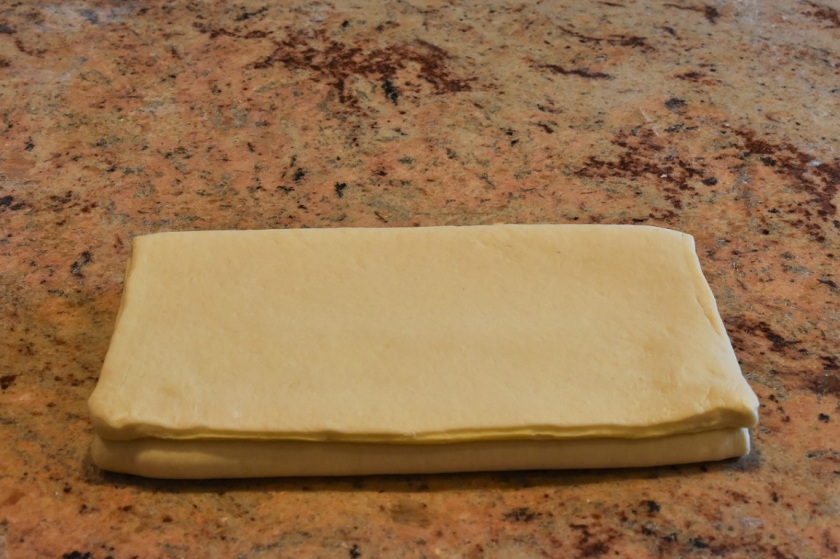
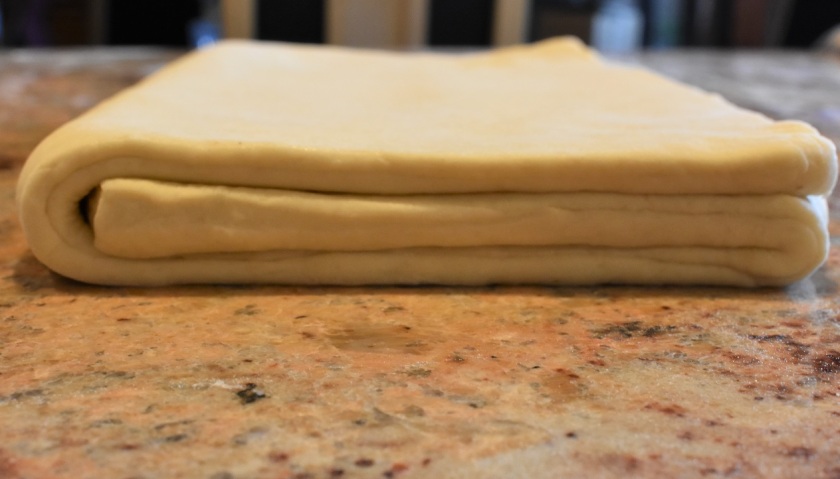
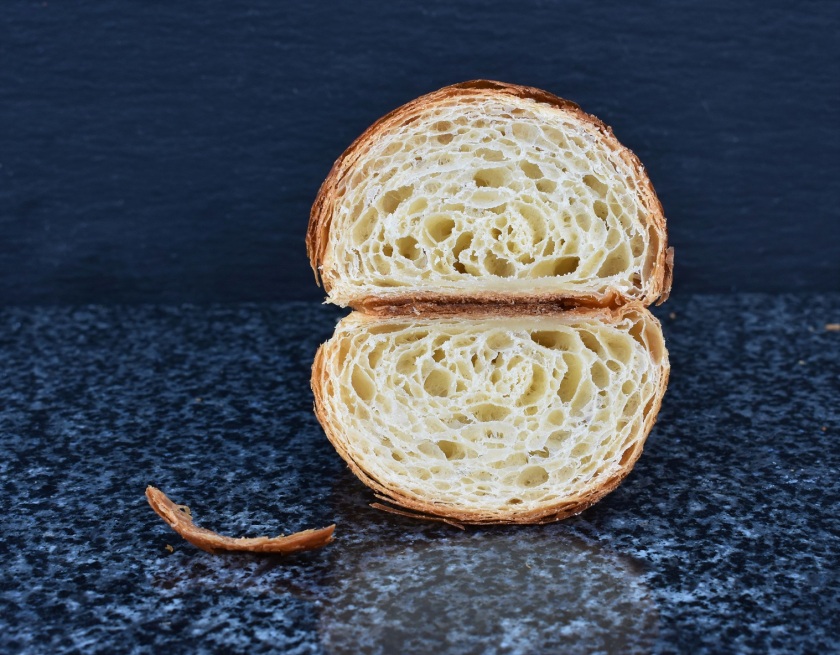
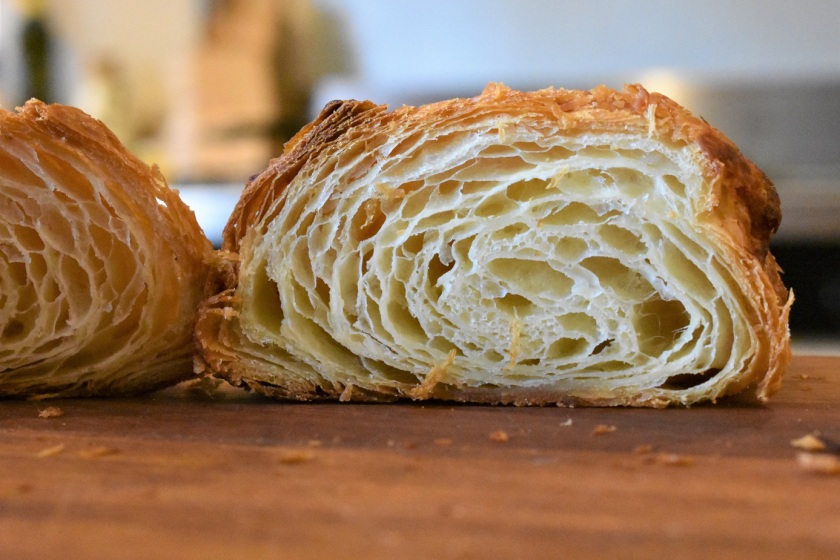



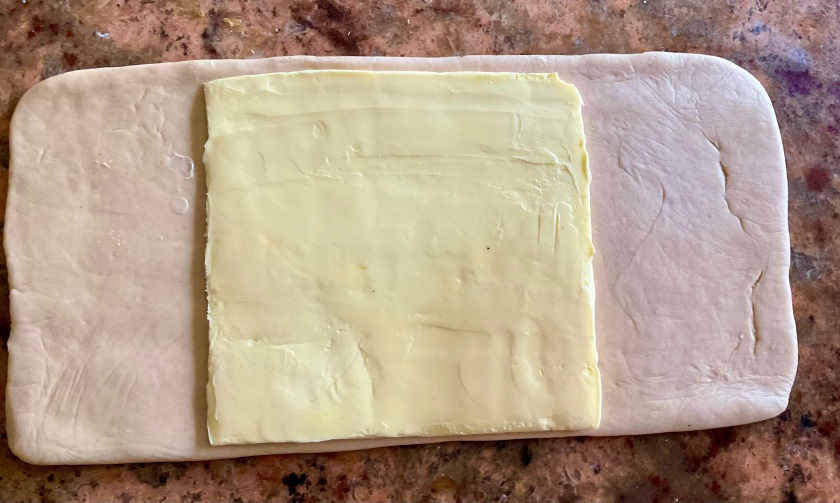
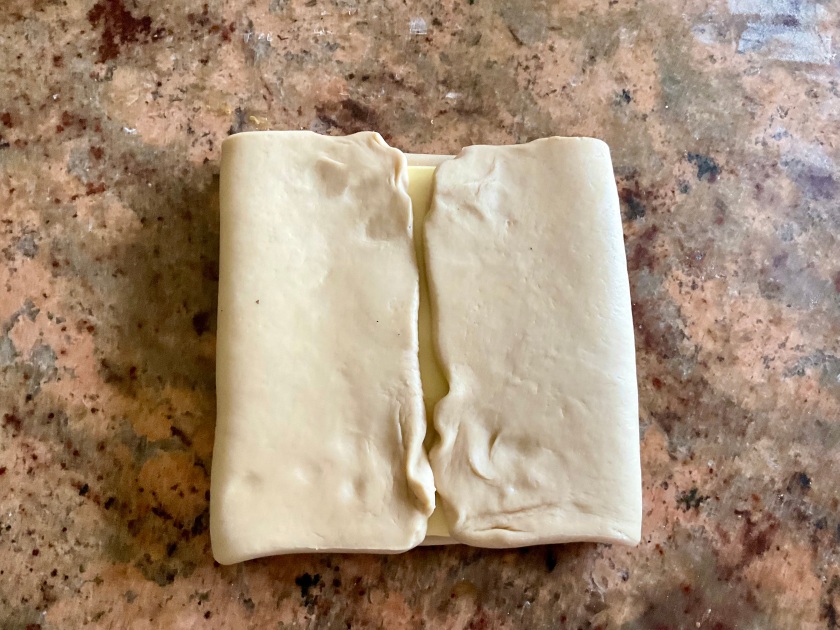
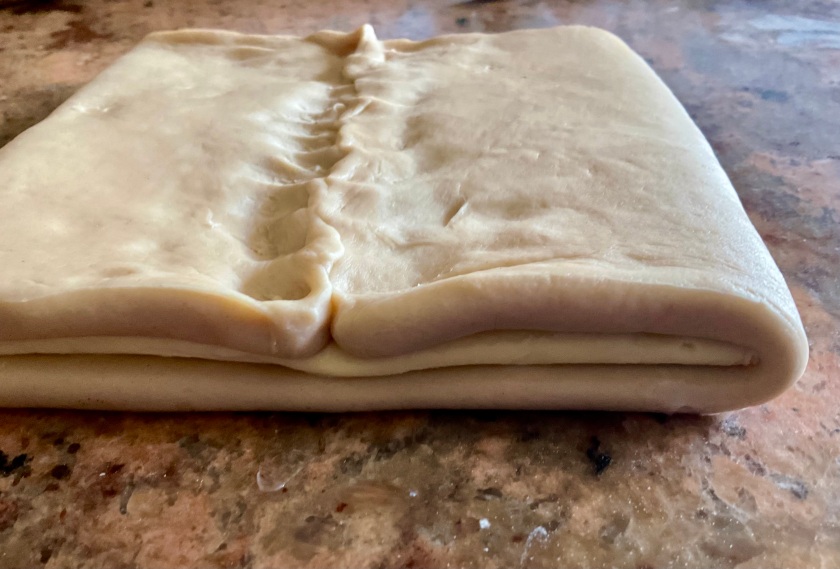
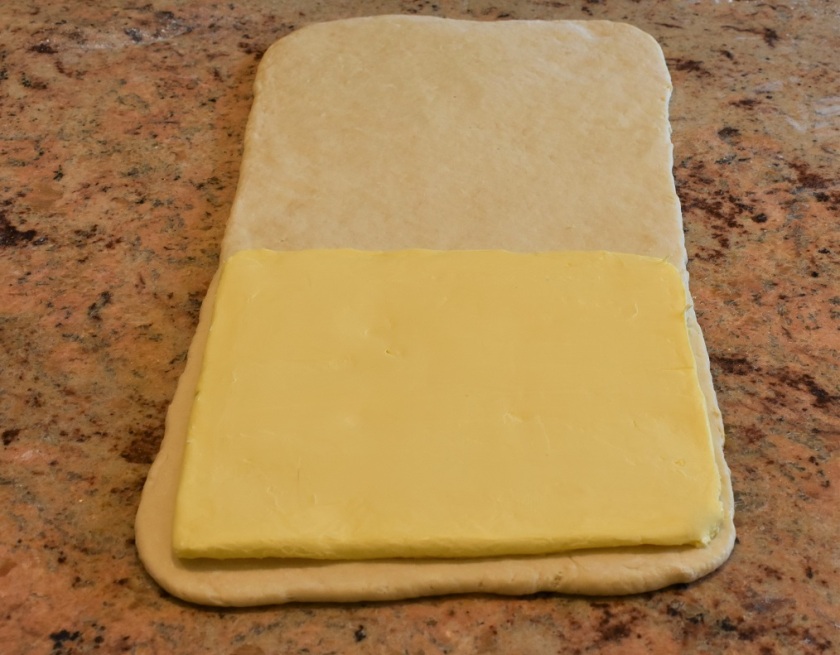
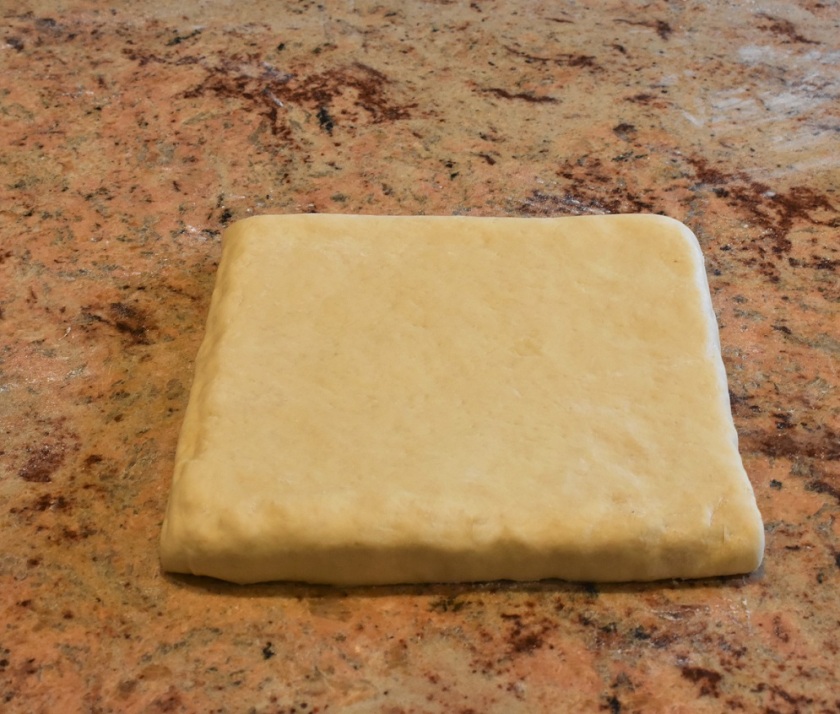
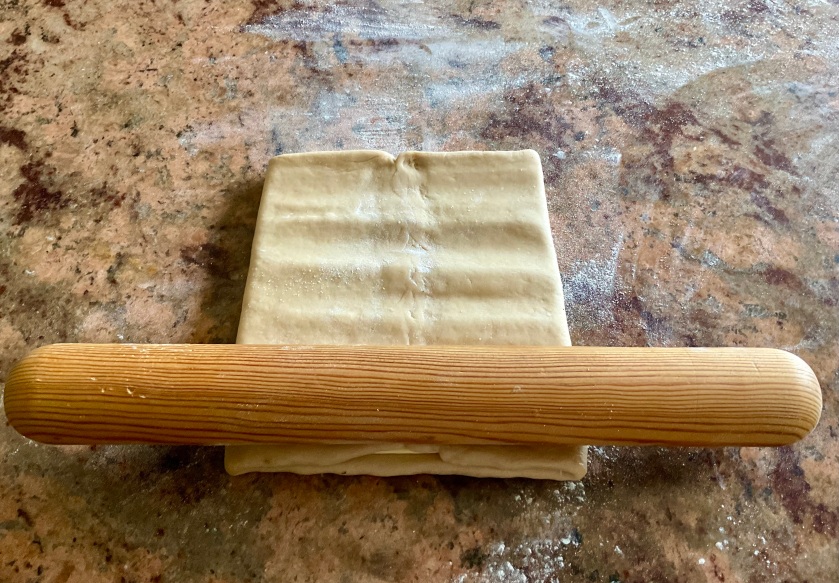
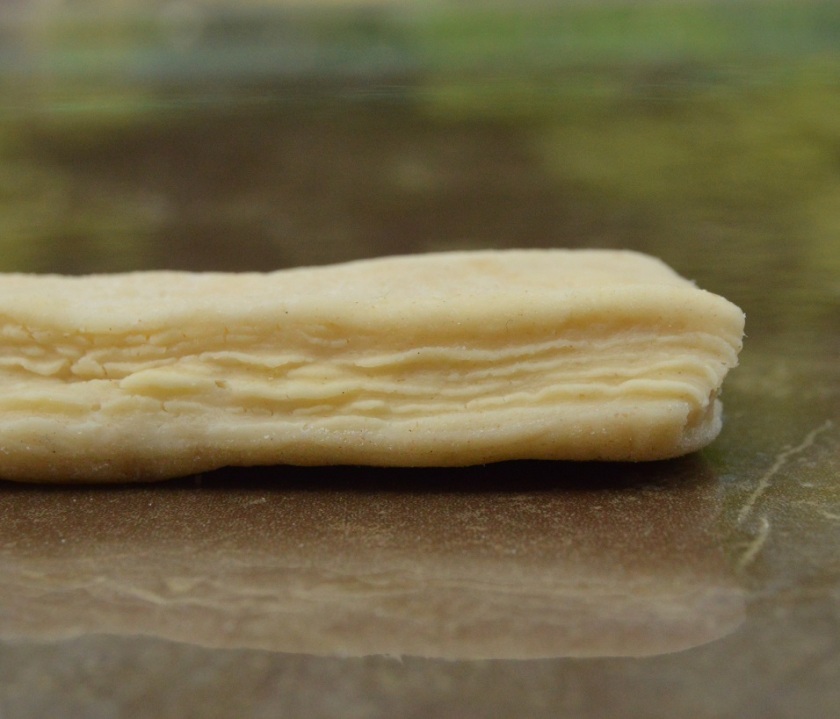

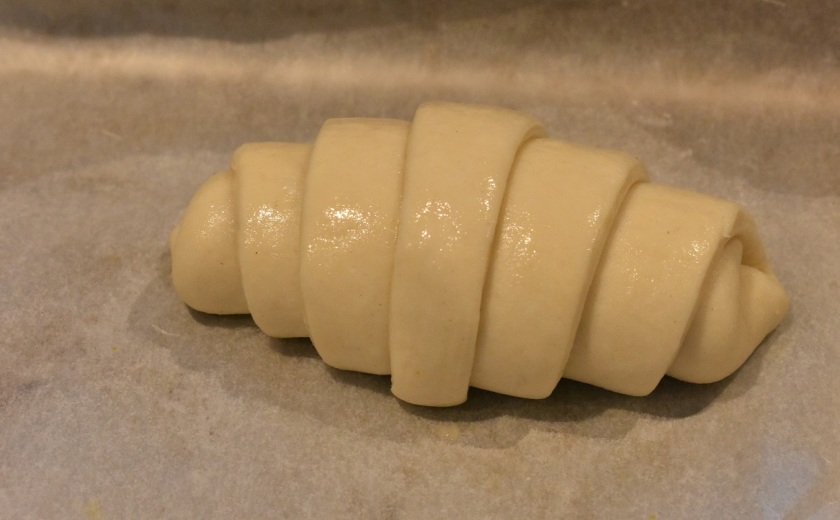

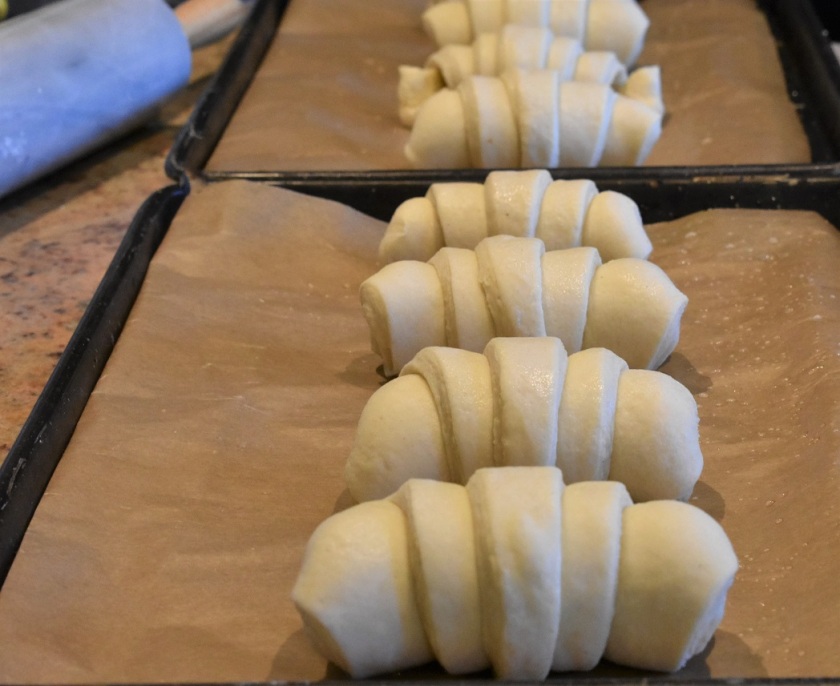



















The croissants are beautiful. Croissants are probably my favorite thing in the world to eat. It is pretty rare that I do eat them but would love to try and make them. Maybe on a cool day this fall- I’m bookmarking this recipe!
LikeLike
Thank you. Yes, croissants are great to eat. Do make some – it’s great fun.
LikeLike
Reblogged this on Bunz Bakes.
LikeLike
Nice post well done. You can really see how your laminating technique has gotten better from 2010 to 2012 to 2013 in the finished product. Laminating is for sure an art that takes time to perfect. Check out our Kouign Amann. It took me 9 months of doing it 6 days a week to get to that point and you really have to push yourself to be better every day.
LikeLike
Ah, i have never eaten let alone tried to make Kouign Amann but will certainly given them a go. They look gorgeous.
LikeLike
At last a recipe for croissants that works properly for me. I followed your advice to the letter and got amazing results. I agree with you about the resting. the more the better for sure.
LikeLike
Definitely on the resting. And you can just let them do their thing while getting on with other things!
LikeLike
I have made croissants for years but have usually suffered with doughy rather than flaky croissants so I tried these out. First time round I didn’t rest them overnight and although they flaked ok they were not as light inside but they tasted great. Second time I did rest them overnight and they were perfect. Thank you.
LikeLike
Glad they worked out. It’s always a joy to get the flake and the lightness inside
LikeLike
Reblogged this on bakingfanatic and commented:
Updated with further troubleshooting and general tips
LikeLike
Made these this weekend and they turned out great. I was a little concerned though when I saw that some of the butter was leaking out, even though I’d kept them in the fridge after proofing. (Had to open all the windows in the kitchen as it was getting smoky, I’m sure the neighbours thought I was burning something, little did they know it was only butter!). Got the dimensions slightly wrong on the pain au Chocolat, the dough seemed quite small, but the end result is what counts and they are very tasty. Am going to have to stock up on uncooked croissants for the summer, when it is definitely too hot, here in Spain!
LikeLiked by 1 person
Hi there, just want to say thank you for this post; it’s really helped me to improve my croissants I notice you’ve changed your recipe to use all strong flour instead of a mix as well as a few other tweaks. Could you explain what the benefits of the new recipe are?
LikeLike
Hi, yes I just switched to strong flour but purely to give a slightly firmer interior. But to be honest there is not a lot in it. The normal plain flour works excellently though and to be honest I vary between a mix and between all strong.
I also now roll out a little less lengthways before: purely for less chance for me to over-do the rolling and risk squashing some of the layers. You still get excellent flakes and a nice honeycombed structure.
I am glad you have found the recipe and tips useful.
LikeLike
if you are in a hot place, like Mumbai, what do you do for the final proving? Can you prove inside a fridge albeit longer. I don’t want the butter to melt while proving.
LikeLike
Yes the fridge is best to use in such heat; they will rise slowly but surely and when they have risen a fair bit put them straight into the hot oven.
LikeLike